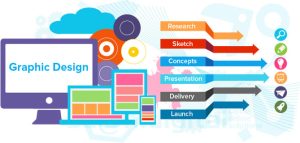The connection between graphic design and printing is obvious. It’s everywhere: from buttons in elevators to store signage to T-shirts. In print, the art of combining text, images, and logic is essential to convey the intended message. But how does graphic design differ from other forms of media? Read on to find out. And be sure to check out our other articles on this topic. There’s something for everyone. Here are the basics of graphic design and printing.

Brand and Marketing is the primary point of contact between the company and external suppliers. It provides a full suite of graphic design and print services at competitive rates. Their preferred supplier is key2creative, which is known for its ability to deliver a high-quality design within budget. Clients can access a variety of designers and copywriters through key2creative. All they need is a creative brief to begin the process. Then, the creative team can get to work.
Graphic design and printing are vital elements in any content-producing process. Without effective graphic design, a piece of content is worthless. A great graphical representation of an idea is of no use unless it can be reproduced and printed. Therefore, the two disciplines are closely related and complement each other. The process is equally important in the case of both print-based and digital-based media. For example, print-based marketing materials need to have specific print boundaries.
If the project requires a specific format, a designer should follow a design guide and adhere to best practices. A design guide will help avoid common mistakes related to fonts, alignment, and hierarchy. When designing for print, remember that space is limited. The best composition practices are also applicable in this case. Furthermore, it’s important to consider size and sizing issues. If the design isn’t compatible with the medium, the end product will not be aesthetically pleasing.
Besides using the right resolution and paper size, graphic designers should keep in mind the quality of print. A print with low resolution will have grainy edges. The same applies to images with low resolution. This can lead to pixelation. If the resolution is too high, the printed materials will look blurry. In other words, you should avoid stretching the images or text too much. These methods will make your print look lower quality. But keep in mind that they are not the only factors that matter in print-based marketing.
If you’re a newbie to the world of graphic design and printing, you might want to consider hiring a print company to handle your project. A printing company with experience in this industry can give you great visuals that will get your message across. A good print company will have the expertise to avoid the many problems that could arise when using nonprofessional printing companies. They also know how to work with clients, so they can help them get their message across effectively.
Graphic design and printing are closely related. Both are important, but each has its unique characteristics. While graphic design involves digital creation, printing involves the creation of printed media. Print designs are used in magazines, flyers, posters, and other physical publications. Prints also play a significant role in marketing and brand awareness. But it is important to understand the difference between these two fields. So, what do you need to understand about graphic design and printing?
There are different color spaces for web and print media. For example, CMYK refers to color space in print, while RGB stands for red, green, and blue. The difference between the two is the way that colors are displayed. If your design is in RGB, for example, it will display colors differently if printed in CMYK, while in CMYK, the colors will look similar on both. And, if you’re converting an image from one format to another, you can end up with a document with weird tones or colors.
The development of printmaking technology led to the emergence of movable type and manuscripts. China developed woodblock printing in the sixth century ce. Woodblock printing, which involves inking a raised surface, made it possible to make multiple copies of texts and images. Chinese people also developed paper made from organic fibres in the 105th century ce. This material was more affordable than papyrus, which had to be prepared by hand.
Graphic designers work with a variety of file types. These files can be classified as vector or bitmap. Bitmaps are made of tiny squares, while vector images are composed of lines, or vertices. When you enlarge them, raster images can cause distortion. Vectors have no such limitations, and can be enlarged in size without losing quality. If you’re creating an image for print, vector graphics will ensure its quality.